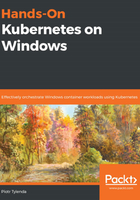
Linux versus Windows containers
Containerization on both Linux and Windows aims to achieve the same goal – creating predictable and lightweight environments that are isolated from other applications. For Linux, a classic example of container usage can be running a Python RESTful API written in Flask, without worrying about conflicts between Python modules that are required by other applications. Similarly, for Windows, the containers can be used to host an Internet Information Services (IIS) web server that's entirely isolated from other workloads running on the same machine.
Compared to traditional hardware virtualization, containerization comes at the cost of being tightly coupled with the host OS since it uses the same kernel to provide multiple isolated user spaces. This means that running Windows containers on the Linux OS or running Linux containers on the Windows OS is not possible natively without the additional help of traditional hardware virtualization techniques.
In this book, we will focus on the Docker container platform, which is required for running containers on Windows. Now, let's summarize the current state of containerization support on Linux and Windows that's provided by Docker Engine and what the possible solutions are when it comes to development and production scenarios.